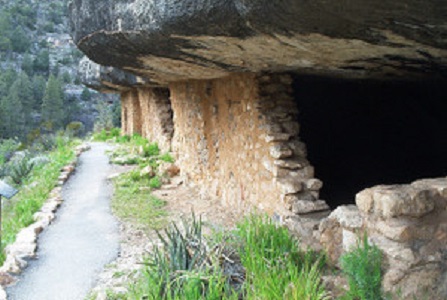
Courtesy of Bob Nandgate through Flickr's Creative Commons
The rugged terrain in the Flagstaff, Arizona area was home to the Ancestral Puebloans from whom the present day Hopi are descended. Known by their descendants as Hisatsinom, meaning people of long ago, the Hopi ancestors lived in this region for more than 800 years. Although they were not the first to inhabit the Flagstaff area, the Hopi ancestors were the first residents to establish permanent dwellings in a 20-miles long, 400-feet deep, and ¼-mile wide canyon. Walnut Canyon National Monument preserves these cliffside homes, which tell the story of the Ancestral Puebloans of Flagstaff and their influence on Hopi culture today.
Believed to have lived in the Flagstaff area from 600 until 1400 AD, the Hopi ancestors were an innovative people who managed to sustain their community in an arid region. Archeologists named this group of Ancestral Puebloans the Sinagua, meaning without water, to embody their lifestyle and stand as a testament to the culture’s exemplary agricultural skills. Like many Pueblo communities of the American Southwest, the Sinagua employed dry-farming techniques to harvest corn, squash, and beans in volcanic terrain. Otherwise known as the “three sisters,” these crops were drought-resistant and ideal for dry farming, since corn can tolerate the sun and shade its lower growing sister crops, squash and beans, which do not require direct sunlight in order to thrive.
To irrigate these crops in the semi-arid climate, the Sinagua built terraces and small rock check dams that allowed them to conserve rainwater. They also collected water from Walnut Creek, but this source of water was not reliable since the creek did not flow all year. Although the crops grown on the canyon rims provided most of their food, the Sinagua also took advantage of the region’s wild life and natural resources. To add protein to their diet, the Sinagua hunted deer, bighorn sheep, and several smaller animals that lived within and around Walnut Canyon. They also ate wild grapes, berries, yucca, and the Arizona black walnut. Other plants used for food and medicinal purposes grew on the canyon rims, where they cultivated their crops and established the first Sinagua homes.
When the Ancestral Puebloans first settled the region in about 600 AD, the Sinagua people around Flagstaff lived in pithouses and freestanding pueblos scattered along the canyon rims. Eventually, as the community expanded, Sinagua pithouse architecture changed. By the 1100s, the Sinagua were living in alcoves below the canyon rim, where the women constructed unique cliff dwellings still visible throughout the canyon today. Using limestone rocks cemented with golden colored clay, the women formed walls around the eroded limestone caves and reinforced their doorways with wooden beams. Traditionally, they located most of their dwellings in the southern and eastern parts of Walnut Canyon to take advantage of the sunlight, but some were also on the north and west sides for use during warmer periods.
Although the Sinagua only lived in these alcoves for approximately 125 years, the Walnut Canyon cliff dwellings are the most visible ruins of the National Monument’s 232 prehistoric sites. When the Sinagua moved to nearby villages in 1250, they left behind over 80 dwellings with three to four rooms each. Together, the six meters long by three-meter deep enclosures house up to 300 rooms, but only 25 of these cliff dwellings are visible to tourists traveling along the canyon footpaths, since pothunters in the 1880s dynamited the cliff dwellings in search of Sinagua possessions. This resulted in the loss of some Sinagua artifacts, but the surviving cliff dwellings, pithouses, and finds from archeological excavations throughout Flagstaff offer great insight into the Sinagua farming community’s life in Walnut Canyon.
Visitors may begin their tour of Walnut Canyon National Monument at the visitor center, where native artifacts and museum exhibits are on display. The bookstore is also at the visitor center, and in the lobby, visitors can enjoy the panoramic views of the canyon and distant mountains. To tour the canyon, visitors can follow the Island and Rim trails, two paved footpaths that begin at the visitor center. The Island Trail is a mile long loop to the Sinagua cliff dwellings, and the Rim Trail is a self-guided tour that takes visitors on a half hour trip along the canyon’s perimeter and through the Ponderosa forest. On the Rim Trail, visitors will also see two canyon overlooks, a pithouse, and other pueblo ruins.
Walnut Canyon National Monument also offers two ranger-guided hikes, which require reservations. The Ledge Hike lasts four hours, and the Ranger Cabin Walk is a two-hour hike. Visitors can also picnic in designated areas, but no camping is available in the park. Information on nearby lodging and campgrounds, including the Bonito Campground at Sunset Crater Volcano National Monument, is available on the Walnut Canyon National Monument website.
Walnut Canyon National Monument, a unit of the National Park System, is located east of Flagstaff, AZ off exit 204 on I-40. Click for the National Register of Historic Places file: text and photos. The Walnut Canyon park grounds and visitor center are open daily except for Christmas and New Year's day. Park trails close an hour before the park grounds and visitor center. There is an admission fee. For more information on current park hours, visit the National Park Service Walnut Canyon National Monument website or call 928-526-3367
Last updated: August 7, 2017
